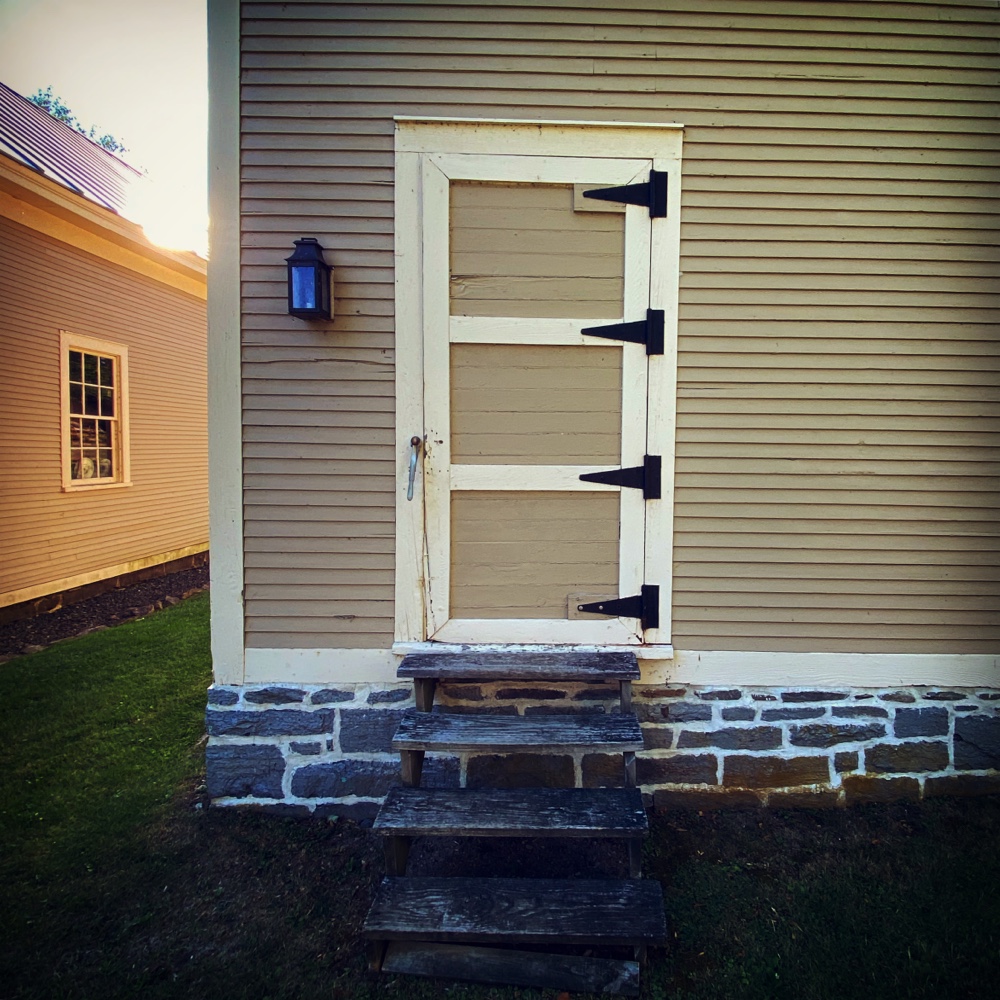
I’d like to shift your focus for a moment to the almost-ready-for-groundbreaking rehabilitation of Rosslyn’s historic icehouse situated just north of the carriage barn. Has your focus shifted? Good. Now let’s zoom in a little tighter to the icehouse door. Perhaps imagine yourself walking south on the sidewalk in front of Rosslyn, looking across the front lawn past the stone wall, toward the setting sun. Can you see the west facade of the icehouse? Can you see the door?
Icehouse Door Haiku
Sightlines and viewsheds
in the historic district
hinge upon a door.
— Geo Davis
As I’ve remarked in the past, there are times when a tidy haiku might accomplish more than a verbose dissertation. If in your estimation my mission is accomplished in the seventeen syllables ahead, I invite you to abbreviate your read here.
If you’re inclined to probe a little deeper, or simply have no clue what I’m getting at, please read on. But, note that a dissertation isn’t in the offing. I’ll take a reasonable run at the idea(s) in the haiku above, but the bottom line is this. The west facade of Rosslyn’s icehouse is within the public viewshed and various sightlines reveal the icehouse door from sidewalk, road, etc. What does that mean, and why is it important?
Sightlines & Viewsheds
In architecture, design, and urban planning “sightlines” is a relatively self-explanatory term combining perspective and line-of-sight visibility within built and unbuilt environments. Hhhmmm… I’m pretty certain that armchair definition wouldn’t pass muster with the AIA, so let’s try a different approach. Within a building or any space, really, what you can see and the relationships between what you can see are your sightlines. What is visible? What is partially or completely obscured? How do visible elements relate to one another? Is the relationship between visible elements visually appealing?
Okay, so what about “viewshed”?
The good folks at Merriam-Webster define viewshed as “the natural environment that is visible from one or more viewing points”. Sounds a little bit like the way I’ve tried to explain sightlines. Let’s see if I can muddle things even further by dipping into the collective genius of Wikipedia.
A viewshed is the geographical area that is visible from a location. It includes all surrounding points that are in line-of-sight with that location and excludes points that are beyond the horizon or obstructed by terrain and other features (e.g., buildings, trees). Conversely, it can also refer to area from which an object can be seen. A viewshed is not necessarily “visible” to humans… (Source: Wikipedia, September 18, 2022)
All cleared up? No? Hhhmmm… Let’s tap a few other resources.
Viewsheds are visualizations of what is visible from a given point and are often used in urban planning. (Source: ArcGIS CityEngine Resources)
When I was 5 years old, I used to play hide-and-seek with my friends. Just like any kid, I’d always try to find the best hiding spots. I used to wonder: If I hide in this spot, what is visible from the observer’s point of view all around them (viewsheds)? Or if the observer looks in a straight line, what is obstructed or not (line of sight)? (Source: Line of Sight vs Viewshed: Visibility Analysis – GIS Geography)
Assessing what’s visible in a straight line from an observer’s specific location involves consideration for obstructions, topographical/elevation change, etc. This, as I understand it, is the sightline. Whereas the viewshed encompasses all visible objects and areas from the observer’s point of view.
In the case of our about-to-start icehouse rehabilitation, both the public viewshed (from the road, the sidewalk, even the lake which is a public thoroughfare) and the various sightlines (all three I’ve mentioned not only offer multiple perspective and multiple lines-of-sight on a spectrum from roughly north-to-south, but they also represent different elevations ergo unique topographical angles) are relevant, and they loosely informed the considerations of the Town of Essex Planning Board (and general public) when we presented our proposal this past July and August.
Essex Village Historic District
Because Rosslyn is a prominent part of the Essex Village Historic District, and because the historic icehouse is deemed important within the historic district’s public viewshed, the icehouse door became a point of discussion during our Planning Board approval process. The discourse and consideration is actually quite interesting. Historic icehouse. Historic icehouse doors. Historic District. Public viewshed. Public sightlines.
I’m going to treat this as a two-part post, this first installment to introduce the relevant considerations, and a follow-up once design decisions are finalized. For now, I’ll withhold the drawings as originally presented, in order to stimulate your own contemplation…
What do you think?